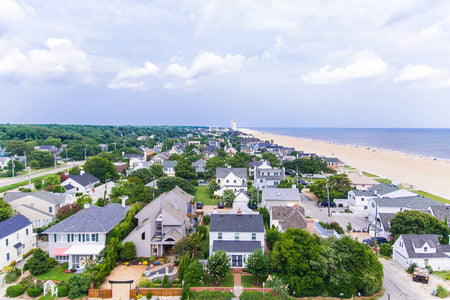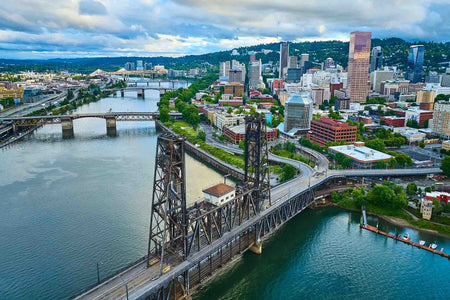- Pollen season in Minnesota begins in early spring and ends in late summer to fall.
- Common allergens include oak, maple, birch, Kentucky bluegrass, ragweed, mold spores, and pet dander.
- Track pollen levels, keep windows closed, shower after outdoor activities, and consider using a combination nasal spray like Allermi.
Minnesota’s breathtaking landscapes — from its lush forests and countless lakes to its vast prairies — make it a state like no other. But beneath this natural beauty lies a challenge for allergy sufferers: a seasonal cycle that brings sneezing, itchy eyes, and congestion.
The long, cold winters followed by rapid spring warm-ups and humid summers create the perfect conditions for allergens to thrive. If you're wondering when allergy season begins, peaks, and finally ends in Minnesota, here’s what you can expect.
When is the Pollen Season in Minnesota?
Pollen season in Minnesota varies slightly by region but generally follows a similar pattern across the state.
In southern Minnesota, the warmer temperatures allow trees to start releasing pollen as early as late March or early April. On the other hand, grass pollen peaks as temperatures rise in late spring and early summer, typically from late May through early July. Ragweed and other weed pollens thrive in late summer and continue until the first frost, which occurs earlier in northern Minnesota (often late September).
In northern Minnesota, the colder climate delays the start of allergy season. Tree pollen emerges in mid to late April and grass pollen peaks in June. Weed pollen follows a similar schedule but may taper off sooner due to earlier frosts, which are common in this region.
What are the Worst Months for Allergies in Minnesota?
The worst months for allergies in Minnesota are typically May, June, and September.
- Spring (May). This month marks the peak of tree pollen allergies, primarily from species such as oak (northern red oak and bur oak), maple (sugar maple and red maple), and birch (paper birch and yellow birch).
- Summer (June). Grass pollen becomes problematic in late May and June, particularly in southern regions. Kentucky bluegrass and ryegrass are common grasses in Minnesota and are known to release high levels of pollen. Kentucky bluegrass is commonly used in lawns, parks, and sports fields, whereas ryegrass is usually found in pastures, meadows, and as a cover crop.
- Fall (September). Ragweed is a major contributor to weed pollen allergies in Minnesota. Although ragweed pollen can travel long distances, it is most concentrated in areas with open fields, roadsides, and disturbed land.
When Does Pollen Season End in Minnesota?
In Northern Minnesota, pollen season often ends around mid to late September due to the earlier arrival of colder temperatures and frost in this region.
In Central Minnesota, the pollen season usually concludes in late September or early October as frosts become more frequent.
Southern Minnesota pollen season often extends into early to mid-October, as frost arrives later due to the warmer climate in this region compared to the north.
Common Allergens in Minnesota
Whether you’re exploring the forests or enjoying a sunny day in the city, you may encounter allergens that are particularly common in the state.
Here’s a closer look at some of the most frequent culprits:
- Oak
- Maple
- Birch
- Cedar
- Kentucky bluegrass
- Timothy grass
- Ragweed
- Nettle
- Pigweed
- Mold spore
- Dust mites
-
Pet dander
How to Prepare for Seasonal Allergies in Minnesota
Given the state’s fluctuating pollen levels and varying climates, dealing with seasonal allergies in Minnesota can be tricky. Here are some steps you can take to reduce your exposure or lessen symptoms in case in case allergens become a problem:
- Track pollen levels. Pollen counts are typically lower after rain or early in the evening, so planning your time outside during these periods can be helpful. Check pollen forecasts so you can avoid times when pollen levels are high and take prophylactic medication [*][*].
- Keep windows closed and use air conditioning to cool your home and car. When you open windows, pollen from trees, grasses, and weeds can easily enter your home or car. Air conditioning, on the other hand, provides a more controlled environment by filtering out pollen and other airborne particles while cooling your space.
- Shower and change clothes after being outdoors. In Minnesota, popular outdoor spaces where allergens like pollen are most prevalent include parks, forests, hiking trails, and lakesides. Even in everyday outdoor environments, such as local backyards, community gardens, or walking trails, allergens can be abundant. Remember to shower and change clothes after spending time in these areas to minimize the amount of pollen you bring indoors.
- Clean regularly. Vacuum carpets and upholstery with a HEPA filter vacuum, dust surfaces with damp cloths, and wash bedding weekly to eliminate allergens like pollen, dust mites, and pet dander.
- Use air purifiers. HEPA filters can effectively capture airborne allergens like pollen, mold spores, and dust. These filters trap particles as small as 0.3 microns, which is ideal for removing common allergens found in Minnesota homes [*].
- Take allergy medications. Use antihistamines or decongestants as recommended by your doctor, before the allergy season begins. A combination nasal spray, like Allermi, can be a great alternative as it targets multiple symptoms at once for more complete relief than a single medication. Learn more here.
- Wear protective gear. Wearing a mask helps filter out pollen, which reduces respiratory exposure, while sunglasses protect your eyes from pollen that can cause irritation and itching.
These simple precautions can make a noticeable difference, especially for those who are highly sensitive to pollen in Minnesota’s diverse outdoor environments.
The Bottom Line
The pollen season in Minnesota typically begins in early spring with tree pollen, peaks in late spring and early summer with grass pollen, and ends in late summer to fall with weed pollen, particularly ragweed.
Remember to stay proactive with your allergy care and consider using a combination nasal spray like Allermi, which targets multiple symptoms.
References:
- Seasonal Allergies | Causes, Symptoms & Treatment | ACAAI Public Website. (2022d, November 7). ACAAI Patient. https://acaai.org/allergies/allergic-conditions/seasonal-allergies/
- Levetin, Estelle & Van de Water, Peter. (2003). Pollen count forecasting. Immunology and allergy clinics of North America. 23. 423-42. 10.1016/S0889-8561(03)00019-5.
- Dubey, S., Rohra, H., & Taneja, A. (2021). Assessing effectiveness of air purifiers (HEPA) for controlling indoor particulate pollution. Heliyon, 7(9), e07976. https://doi.org/10.1016/j.heliyon.2021.e07976









